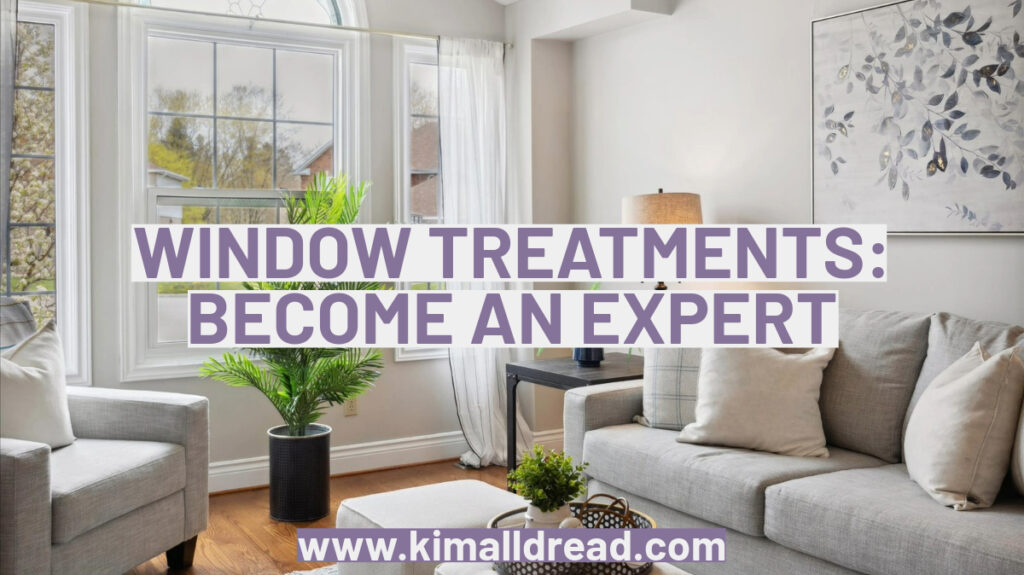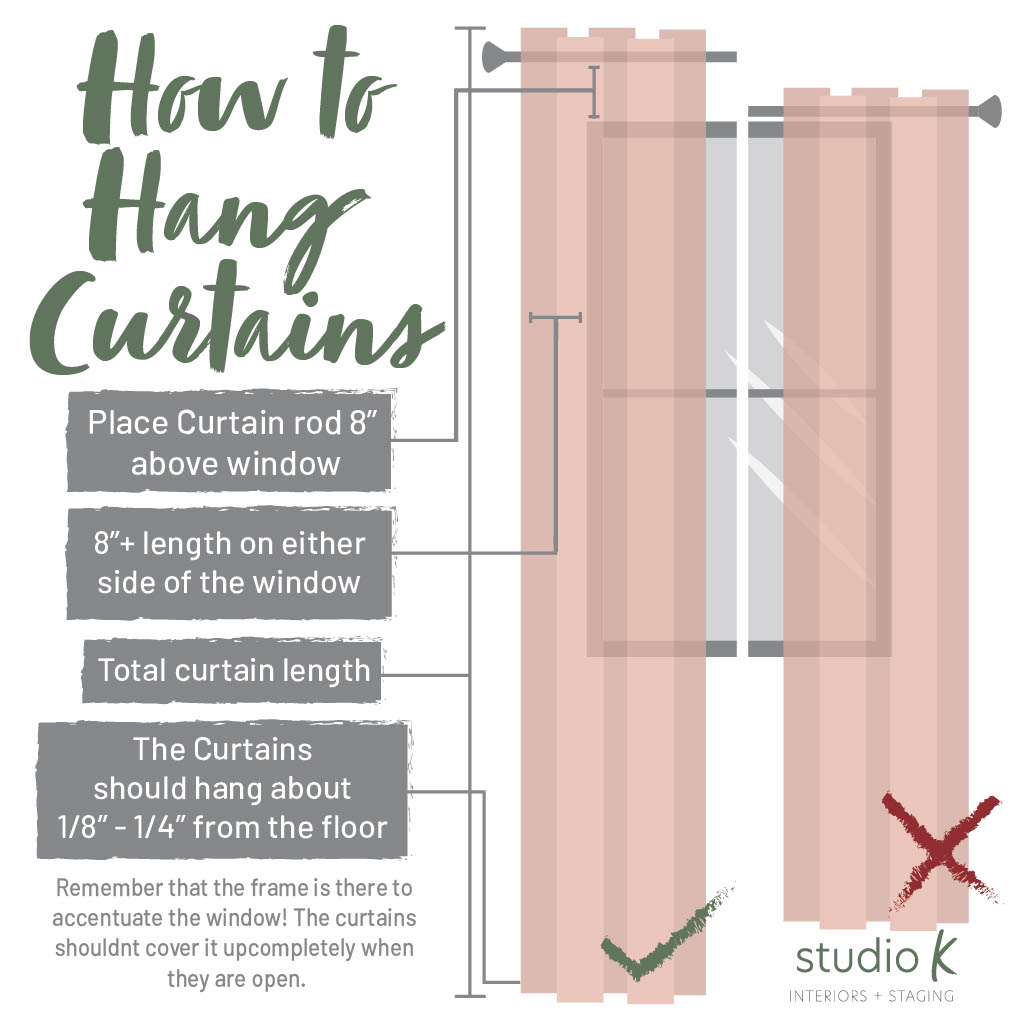
We love having our homes filled with natural light, but when it comes to finishing your interior design plans window treatments can make or break the overall look. In this blog we are going to be giving you all our knowhow on window treatments so that you too can become an expert. We’ll dive into why they are important, go through the different types of window treatments and their best uses, and will give you some important professional pointers to help you through the styling process.
A well-dressed window creates a certain ambience to elevate your design plan and ultimately complete your space. Not choosing the correct window treatments can be lackluster and will simply not look right. But they don’t just serve your home to enhance your aesthetic, they also contribute to your quality of life. We consider window treatments as an important item to be included in your budgeting as they hold power over your privacy, light control, and overall design.
Types of Window Treatments
There are six types of window treatments, all of which have their own functions, and benefits. Below you will find a breakdown of each:
Shutters
Shutters have become a popular choice when choosing window treatments recently. They are not only functional and beautiful window treatments, but they can also add value to your home. We love that they add a timeless, traditional sophistication to any room. Shutters help with light control, provide your home privacy when closed, and helps to insulate against heat, cold, and sound.
There are a few of style options for you to choose from when picking your shutters, below we have listed them and their different benefits:
- Full Height – covering the entire height of the window. Offering excellent privacy and light control, and are compatible with most window types.
- Café Style – only covering part of the window starting from the bottom. This option is perfect if you desire privacy in a cost effective way.
- Tier on Tier – similar to full height in the way they cover the window, featuring two or more panels that can be operated independently. Making them the most flexible shutter type option.
- Solid Panel – leaving the louvres behind, solid panels are a traditional window dressing option. Offering great noise insulation and privacy to your home.
Curtains & Drapes
Curtains & Drapes are the same thing and refer to full-length fabric panels hung from a drapery rod above a window. They are the most decorative option for window treatments and come in many different fabric options, such as cotton, hemp, linen, velvet, silk, and polyester. Each fabric type will vary for light control and privacy, as well as some may include a liner for extra light filtration. If you are looking for a polished, custom, and design-forward window treatment plan, curtains & drapes are most used to layer with other window treatment options. Layering is commonly used alongside a timeless wood blind, an insulating cellular shade, or a rustic woven wood shade – but feel free to adventure for your own customized look.
You can use a single panel for single windows, and double panels for larger window – we like using double panels in living areas. There are also window tier curtains that are most used in kitchens, they cover the lower portion of the window leaving the top part of the window uncovered. Follow this infographic to ensure that you are choosing the correct panels and installing your curtains & drapes like a professional.

The three base opacity options for curtains & drapes are sheer, semi-opaque, and blackout. Sheer provides the most amount of daylight, great if you are layering with another window treatment option that provides the desired privacy & light control. Semi-opaque is a combo of sheer and blackout, still offering a bit of privacy but letting light in. Blackout provides the most privacy and amount of darkness, mostly seen in bedrooms.
Roman Shades
Roman Shades are soft window coverings that hang flat against the window when lowered and feature soft drapes or crisp folds of fabric when raised. They can be installed inside the window mount or just outside of it. Available in many fabric options to add colour or texture into your spaces. As well as different styles to fit seamlessly into many décor styles. We have listed the six most popular below:
- Plain Fold – just like it sounds, when the shade is lowered the fold is visible and when it’s raised the fold becomes more pronounces. This style brings more texture and body to your window.
- Swag – have a tail on each end and a relaxed muddle. They are elegant but not functional if wanting to use regularly.
- Soft Fold – the fabrid cascades in a rippling effect so that the window covering retains the loose folds in both the raised and lowered positions. This style can create a romantic and airy feel.
- Tie – another one that explains itself, a shade that lays flat and use ties to determine where in the window it sits. We often see these in kitchens, kids bedrooms, and nurseries.
- Flat Fold – made of a continuous piece of fabric and hangs flat against the window when lowered, but when raised the fabric draws upward in a neat bunch of folds that are reminiscent of cellular shades. They are highly functional and takes little to no work in styling/adjusting when used.
- Relaxed – does not have a rod sewed into the bottom of them so they have a curve once pulled up. A laidback style mainly for decorative purposes.
Roller Shades
Roller shades are pretty simple – when lowered the shade hangs flat near the windowpane, and when raised it rolls up onto a cylindrical rod. They are very easy to control and take up very little space. Not to mention that they are available in lots of fabrics, including blackout, sheer, linen, and a palette of patterns. They are a window treatment that can be mounted inside or outside the window framing. Below we have listed some of the different options available for roller blinds:
- Electric Motorized – good for areas that you have furniture in front of, as well as sliding doors. Or if you want to indulge yourself, install them in your bedroom so you don’t need to leave bed in the morning to let the sunlight in.
- Silhouette – made from two fabrics that are joined giving you the ability to dim a space.
- Duo Roll – made up of two striped fabrics that can be lifted and lowered. Flexible for however much light you may want brought into your space.
Blinds
Blinds have a lifting mechanism similar to shades but are crafted from heavier materials like vinyl, wood, or bamboo. With blinds you also have options ranging from sheer to blackout. Whether you are looking for window treatments that are sleek and modern or traditional and classic, there’s a type of blinds for you. Find the different types below:
- vertical blinds – easy to operate and offer an efficient way to control the amount of light and privacy in any room.
- venetian blinds – horizontal slats that can control amount of light let in, most commonly used type of blinds.
- mini blinds – perform same as venetian blinds, however mini tend to appear more modern and contemporary due to sleek appearance.
- wood blinds – a popular choice if you are looking to add an element of luxury to your window treatments, offering a natural timeless look.
- aluminum blinds – another popular choice as they are affordable and light weight yet durably designed which makes them easy to install and long-lasting.
- panel blinds – good for covering large windows or sliding doors as they are several panels affixed to a headrail at the top of the window.
Valances
Valances are like the frosting on a cake, the exquisite topping that offer an extra layer of decoration. They are soft, fabric treatments at the top part of the window that can be paired with any of the above window treatments – besides shutters as they would not be able to open. Valances are purely decorative, used to conceal curtain rods, and usually cover no more than the upper third of the window.
- Straight Gathered – the most basic kind of valance available, simply sewn into a rectangle with a rod pocket for easy installation.
- Shaped – perfect if you’re looking for more than rectangle valance/straight bottom, shaped can be inexpensive option.
- Traditional Swags – often seen in formal dining rooms or two-story foyer.
- Traditionally Pleated Swag – cuts down on amount of fabric needed and is more modern.
- Scarf – a convenient option, using a single piece of fabric to dress the top of a window giving the look of a scarf.
Congratulations, you are now a window treatment expert! We hope that this blog helped you better understand the different types of window treatments and their best uses while taking notes on a few of our professional tips. If you need help sorting through your options to best suit your home and style, feel free to reach out to us, our in-house interior design team at Studio K would love to help you complete your home’s design plans.